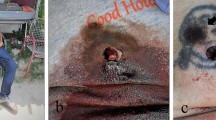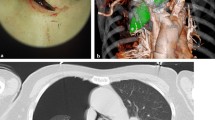Abstract
A 39-year-old man attempted to kill himself using a small knife to penetrate the left anterior chest wall because of trouble at work and with his girlfriend. On arrival at the emergency room, his consciousness was not clear and vital signs were unstable. The knife remained vertically located in the left anterior chest wall. A large left hemothorax was identified by chest X-ray, and moderate cardiac tamponade was detected by echocardiography. Left-sided chest drainage was performed by inserting a chest drainage tube, and about 2500 ml of hemorrhagic effusion was drained. An emergency operation was performed to relieve the cardiac tamponade and repair the penetrating cardiac injury. About an hour after arrival at the emergency room, a median sternotomy was performed in the operating room. The knife had injured the surface of the right ventricular outflow tract, the left lung, and the 3rd intercostal artery and vein. Cardiopulmonary bypass was immediately prepared for the repair of the cardiac injury. The wounds were successfully repaired with pledgeted sutures under cardiac beating. The postoperative course was uneventful with no sign of infection. The patient was discharged at 9 days after the operation. Here we have reported a case of successful surgical repair of a penetrating knife injury to the heart, which was managed by immediate resuscitation and emergency surgery.
Similar content being viewed by others
References
Knott-Craig CJ, Dalton RP, Rossouw GJ, Barnard PM. Penetrating cardiac trauma: management strategy based on 129 surgical emergencies over 2 years. Ann Thorac Surg 1992; 53: 1006–9.
Attar S, Suter CM, Hankins JR, Sequeira A, McLaughlin JS. Penetrating cardiac injuries. Ann Thorac Surg 1991; 51: 711–6.
Mitchell ME, Muakkassa FF, Poole GV, Rhodes RS, Griswold JA. Surgical approach of choice for penetrating cardiac wounds. J Trauma 1993; 34: 17–20.
Velmahos GC, Degiannis E, Souter I, Saadia R. Penetrating trauma to the heart: a relatively innocent injury. Surgery 1994; 115: 694–7.
Karmy-Jones R, van Wijngaarden MH, Talwar MK, Lovoulos C. Cardiopulmonary bypass for resuscitation after penetrating cardiac trauma. Ann Thorac Surg 1996; 61: 1244–5.
Yamada S, Yamazaki M, Mori K, Kosaka A. Successful surgical management of penetrating cardiac injury. Jpn J Thorac Cardiovasc Surg 1998; 46: 953–6.
Ivatury RR, Nallathambi MN, Stahl WM, Rohman M. Penetrating cardiac trauma, quantifying the severity of anatomic and physiologic injury. Ann Surg 1987; 205: 61–6.
Follette DM. Penetrating cardiac injuries — A look to the future. Ann Thorac Surg 1991; 51: 701–2.
Kirklin JW, Barratt-Boyes. Cardiac trauma, in Cardiac Surgery. Second edition, Churchill Livingstone, New York: 1993: 1627–33.
Tavares S, Hankins JR, Moulton AL, Attar S, Ali S, Lincoln S. Management of penetrating cardiac injuries: the role of emergency room thoracotomy. Ann Thorac Surg 1984; 38: 183–7.
Author information
Authors and Affiliations
Rights and permissions
About this article
Cite this article
Furukawa, H., Tsuchiya, K., Ogata, K. et al. Penetrating knife injury to the heart. Jpn J Thorac Caridovasc Surg 48, 142–144 (2000). https://doi.org/10.1007/BF03218111
Received:
Accepted:
Issue Date:
DOI: https://doi.org/10.1007/BF03218111




